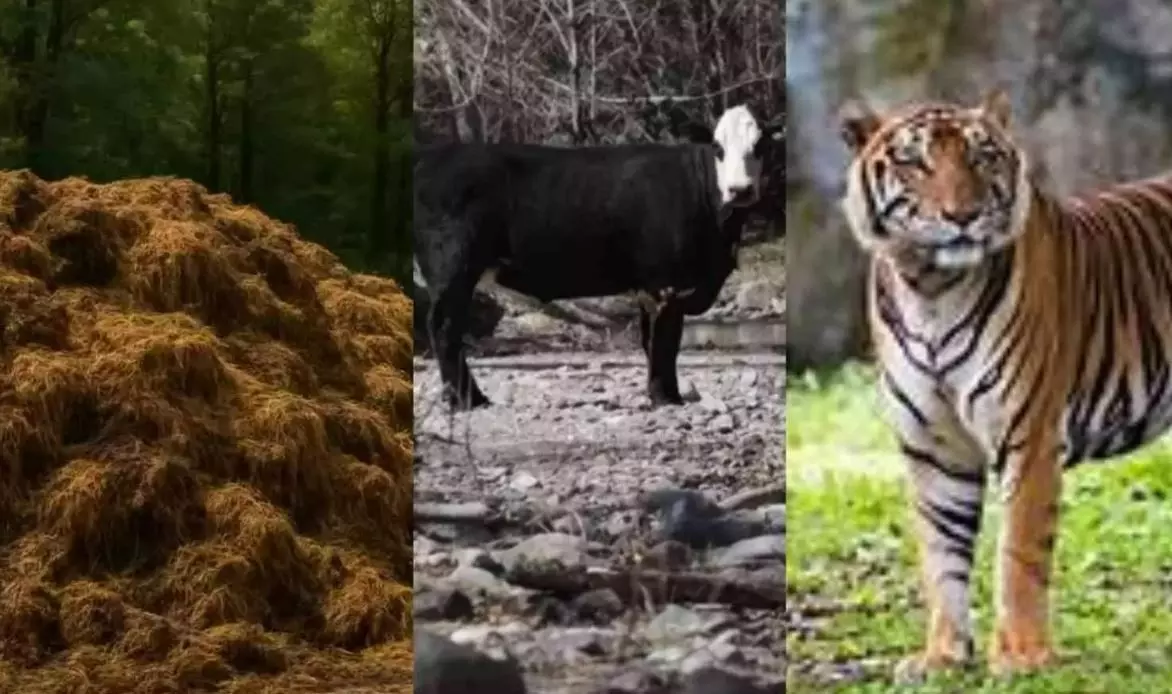
Karnataka tigers’ death: Is cow dung mafia behind poisoning?
Cow dung from Bargur cattle is in high demand in Kerala. They purchase cow dung at rates of up to Rs 2,000 per ton

In Karnataka’s Male Mahadeshwara forest region, the tragic death of a tigress and her four cubs due to poisoning is suspected to be linked to cow dung mafia.
Also read: Karnataka: 5 tigers found dead in one day; special team to probe cause
Previously, the sale of tiger skins, claws, and teeth had given rise to mafia activities in this forest range. However, strict measures by the forest department have curbed tiger hunting. Yet, the alleged silent operations of the cow dung mafia are said to be a major reason behind the rising human-wildlife conflict.
What is cow dung mafia?
In the Tamil Nadu-Karnataka border villages within the Male Mahadeshwara forest area, the Bargur breed of cattle is widely reared. The high demand for cow dung from these cattle has resulted in the emergence of a cow dung mafia. Allegations have surfaced that this mafia may be behind the poisoning of tigers.
Also read: Karnataka tigers' death: Three arrested for 'revenge act' for killing cow
However, Kumar Pushkar, Additional Principal Chief Conservator of Forests (Administration and Coordination), who is heading the state-constituted probe committee, told the media that it is a case of “retaliatory killing” over tiger hunting the cattle that belonged to the accused.
Villages around River Palar — such as Gopinatham, Tamrakere, Bhavani, and Hosamalai — have large numbers of Bargur cattle, mostly raised by members of the Langoji community.
High demand for cow dung in Kerala
Cow dung from Bargur cattle is in high demand in Kerala, mainly for rubber and coffee plantations. Landowners from Kerala who come to these forest border villages purchase cow dung at rates of up to Rs 2,000 per ton. The increased demand has led to a rise in the cattle population, which in turn has resulted in more cases of tiger attacks on cattle.
Nutrient-rich cow dung
The cow dung from Bargur cattle is considered highly nutritious because the animals graze on naturally grown green grass. This cow dung is rich in nitrogen, phosphorus, and potassium, improving soil fertility and increasing yield. This makes Kerala plantation owners eager to acquire it. About 90 per cent of the manure is bought by Kerala landowners, while 10 per cent is purchased by farmers in Tamil Nadu and Karnataka.
If this cow dung trade is indeed operating as a mafia, then the forest department’s negligence is contributing to the rise in human-wildlife conflict. Some officials, however, argue that such incidents occur not because of mafia activity but due to internal problems within the department.
What’s special about Bargur breed?
Bargur cattle are brown-white mixed in colour with sharp horns and tall shoulders. These cattle are known for their adaptability to climatic conditions. Both cows and oxen are found in this breed, though oxen are used less for farming and are mostly kept for rearing. Bargur cows produce very little milk, just enough for household use. Owners with hundreds of cattle let them out for grazing in the forest as maintenance is easy, and one person may take 100–500 cattle and oxen into the forest for grazing.
The grazing system
In the border villages of Tamil Nadu and Karnataka, cattle are often given on lease (called paalige). For example, if 100 cattle are leased out, the caretaker can use them for farming and milk. If these 100 cattle produce 50 calves, 25 go to the owner and 25 to the caretaker. Cow dung collected from these cattle is reserved for the owners. The collected cow dung is usually stacked along the forest edges, and even today, heaps of cow dung can be seen in villages around the Male Mahadeshwara forest.
(This article was originally published in The Federal Karnataka)

